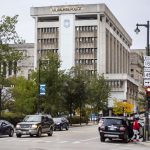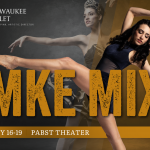Where to go when schools lose funds

Miriam Levie leads children through traditional African dance steps during a summer camp class at Walkers Point Center for the Arts. WPCA offers free arts-based educational classes for neighborhood children throughout the year. Photo by Liz Setterfield
By Cheri Yarborough
As budgets have been squeezed for arts programs in the public schools, many have wondered if there were any enrichment programs still available for K-12 students in the Milwaukee area. Surprisingly, yes — but not in the formats or venues that were there in the past.
With the advent of “No Child Left Behind” mandates, more time in the classroom is allocated to testing, objectives and quantifying progress. Fewer funds are available for what many consider the “frills” of art, music, dance or drama. A few schools may share a traveling specialist in one of these areas, but these programs are rare.
What has taken their place?
With a rich patchwork of community programs, the MPS Partnership for the Arts has filled in the gaps for children from every economic background. According to their web site (www.mpsfoundation.net), the primary goals of the organization include: Expand arts-related experiences for MPS children, youth and adults; increase the number of enriching activities that connect the arts to academic learning; increase resources and support for arts education in the schools and community.
These goals are achieved with government funds allocated by the school board; money that is matched by outside sources, from individuals to foundations and companies. According to Kathleen Kirchhoff, MPS Grant Development Services, “The money is dispensed to programs when matching funds become available.” Matching funds may be in the form of cash matches or in-kind, with a typical 80% cash matches.
Many, if not most, of the programs occur outside of the regular school day. More than 30 community arts partners are participating, and the level of experience of those partners is varied, from well-known arts organizations to student interns.
The program currently has funding of approximately $1.1 million to support the various proposals through 2009-2010. Some of the programs are citywide and some target particular groups and neighborhoods.
How do parents and children find out about what is being offered, and where?
There are 55 schools in the Milwaukee area that host MPS Community Learning Centers. These sites are staging points for a number of before-school and after-school programs. They are run by various non-profit organizations, such as Boys and Girls Clubs, the Latino Community Center, Neighborhood House, Journey House and Silver Spring Neighborhood Center and others. The before-school programming runs from 6:30 a.m. to 8:00 a.m. and after-school runs from 2:30 to 6 p.m. When there are scheduled MPS days off, programs are available from 6:30 a.m. to 6 p.m. Summer Day Camps run for 10 weeks, starting one week after MPS dismisses for the year, and there are activities for winter break.
During the school year, the Community Learning Centers offer everything from safe places for children to stay when parents are still at work and help with homework to specific activities in the arts and sports. Parents can find out what activities are offered, and where, by going to www.MilwaukeeRecreation.net.
Other offerings can be found by looking at specific arts organizations. The Milwaukee Youth Symphony (at www.myso.org) has offerings for gifted youth. Dance groups (such as Ko Thi or Wild Space Dance Company) often have classes for children. Some arts organizations pool resources and space. By going to www.youthartscenter.org you can access the First Stage Children’s Theater, the Milwaukee Youth Symphony Orchestra, Milwaukee Children’s Choir, Festival City Symphony, African American Children’s Theater and Danceworks, all of whom operate under the umbrella of the Milwaukee Youth Arts Center. Their new facility is located at 325 W. Walnut St., just north of downtown Milwaukee.
Walker’s Point Center for the Arts, (www.wpca-milwaukee.org) is one of the smaller organizations offering enrichment classes, and strives to be as accessible as possible to neighborhood children. In operation since 1987, and located at 911 W. National Ave., WPCA supports visual and performing arts in a multi-cultural environment.
Executive Director Gary Tuma says after -school drop-in sessions teach not only dexterity and confidence with art materials, but offer purposeful activities from 3-5 p.m. Tuesday through Friday for many children who may have no alternative after school but to go home to an empty house and wait for their parents to get out of work. Home-schooled children in the neighborhood also have a place to interact with others.
Miriam Levie, a dance teacher at WPCA recently offered, “Most children are eager to start, and are here as soon as the door opens during the summer.” Many come week after week, no matter what is being taught. During one of Levie’s recent classes, boys and girls learned African dance, diligently performing the steps and clapping and whooping to the beat.
The formula that WPCA has established was the subject of a book by WPCA founder Jane Brite and co-author Marlene Jaglinski called Art After School (published in 2001 by Malloy Lithographing). Tuma says that he has received numerous calls and visits over the years from people asking about setting up an arts center in their own city, based on the WPCA model.
Often, parents and educators and financial donors debate the usefulness of the arts. If a child is not particularly gifted, why bother? The simple answer is: Sometimes you have to expose a child to a wide range of activities to see what sparks their interest and where their talents lie.
But beyond that, according to Jerome Kagan of the Dana Foundation (a private foundation with interests in brain science, immunity and arts education), there are numerous reasons why access to the arts is important. “The first advantage is that it boosts the self-confidence among the children who are behind in mastery of reading and arithmetic.” By providing children with opportunities to be successful at some classroom task that has no finite comparable result, art, dance, music and theater enhance concentration and support other learning skills.
Studies of the brain have shown that participating in the arts can enhance the brain structures and function that build competence in math and reading. Most parents and teachers understand these connections. Unfortunately, budget cuts threaten arts programming within our school districts, seemingly more and more each year. It is important that we support the arts programs that are in place for our children, both within and outside of the school walls.

















Please help support the new, endowed youth choir program and St. Paul’s Episcopal Church, E. Knapp St. and Marshall. Two levels will be taught, SATB for older youth, children’s choir for kids grade 3-6. Although uniforms and accidental expenses will occur, this program is tuition free. Offered to all kids who love to sing! Please contact 414-483-3368. Program starts Sept. 15th.